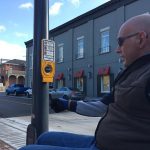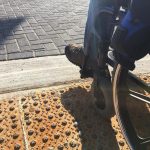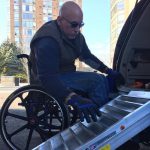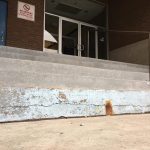
Wade Watts, founder of Wheelchair Friendly Solutions, says downtown revitalization missed mark on accessibility for the disabled. Photo By Brendan Burke, QNet News
By Brendan Burke [1]
BELLEVILLE – Soon after an overseas workplace accident put Wade Watts in a wheelchair three years ago, the former civil engineer noticed something.
“I got back to Canada and I realized very quickly…multiple times, over and over – I couldn’t get anywhere.”
Watts – the founder of a Trenton-based company that provides affordable solutions, including ramps, matting and parking signage to disabled clients seeking improved home and workplace accessibility – says the lack of accessibility for disabled people on city streets is a “huge problem” nationally, provincially – and in Belleville. Watts told QNet News that urban obstacles, often overlooked by able-bodied people, are a roadblock for accessibility in the city.
“It’s the little things,” he said. Steep inclines, outward opening doors, high curbs, sloped sidewalks, minimal wheelchair parking spots, no automatic doors – all subtle obstructions that he says are stopping the city’s disabled from entering shops, restaurants and offices, adding that for special events and concerts, “if you’re disabled, you’re out of luck. You just can’t go.”
According to Watts, outdated or invalid building codes are often to blame for street-side inaccessibility – including infractions found in Belleville’s newly revamped downtown. With only one automatic door and no roadside wheelchair parking space in “phase one,” he said the pricey face-lift was a missed opportunity to bring the city’s core up to speed with accessibility standards.
“When the city redid this, they could have mounded up the sidewalks and sloped them off gently and made all these buildings accessible. All of them.”

Tanya Kingsman says even one high curb or uneven sidewalk can make navigating the city with her walker challenging. Photo By Brendan Burke, QNet News
Instead, Watts said, some buildings and entrances will violate laws once new measures under the Accessibility for Ontarians with Disabilities Act [2] come into effect in January 2018 – when businesses and non-profits with one to 19 employees are required to “make new or redeveloped public spaces” – such as parking lots, service counters and access routes – accessible. Ontario businesses with 50 or more employees must meet the same criteria by the new year.
The Accessibility for Ontarians with Disabilities Act was passed in 2005 in an effort to regulate accessibility standards and “identify, remove and prevent barriers for people with disabilities,” according to Accessibility Ontario’s [3]website. The legislation focuses on five aspects of accessibility: customer service, employment, design and public spaces, information and communication and transportation.
Along with a reluctance to adopt new standards, Watts said a failure from the city’s accessibility committee [4] to consult with disabled people during the project’s design stage also led to the area’s current accessibility shortcomings.
“They don’t have anybody from the disabled community that’s involved in it,” he said. “The status quo of being designed and built by able-bodied people is where the mistake is made.”
QNet News has reached out to the city’s accessibility committee to confirm this claim, but the information wasn’t available by deadline.
Tanya Kingsman, a visually-impaired resident who relies on the use of a walker, said the city’s lack of engagement with the members of the disabled community is a main catalyst behind the area’s accessibility woes.
“They just made things look better rather than actually be better because they refuse to consult people who know what they’re talking about. Stop just listening to people who are paid to tell you what you want to hear,” she said.
Kingsman, a regular Belleville Transit rider, said the challenges associated with accessing city services as a disabled person go beyond curbs and sidewalks. Even as a registered cardholder with the Canadian National Institute for the Blind (CNIB) [5], she said the city does not offer her free ridership, while transit systems in Toronto and Ottawa do. As a result, Kingsman said living with disabilities becomes all the more challenging.
“Navigation is a huge dread for me, because I don’t know what to expect everyday. If I hadn’t grown up here, I’d be totally lost,” she said.
When she isn’t riding the bus to get around, Kingsman uses her walker. She said even the slightest irregularity in roadways can be harmful. But Kingsman said it’s what’s behind the sharp slope or high curb that really hurts.
“If you have a sore already and you go over those kinds of bumps – that hurts. And then you’re reminded that someone just didn’t want to do the work when you go over that. It’s not fair,” she said.
While limited access in the city can be frustrating, Kinsgman said she can count on the accommodations of local businesses – and the kindness of strangers.

Members of Belleville’s disabled community say downtown makeover did little to improve access to storefronts. Photo By Brendan Burke, QNet News
“There are a lot of businesses to give good kudos out to because they do the extra work. People are usually good to stop and give a minute to help,” she said.
Anna Strati-Morrison, regional program manager for the Canadian Hearing Society [6], told QNet News that challenges with accessibility in the deaf community don’t stem from City Hall missteps.
“The City of Belleville does a good job of providing access. If a person or group asks for access the city will provide it. The challenges come from a lack of…registered interpreters,” Strati-Morrison said.
To create more accessibility for deaf people in the city, she encourages “consistent and ongoing training for American Sign Language, deaf culture and sensitivity training.”
According to the City of Belleville’s website, decisions made by the accessibility committee are based on the expectations and guidelines set by the Accessibility for Ontarians with Disabilities Act. The site states that the five accessibility standards outlined by the act are in “various stages of development and implementation.” The nine-member committee includes Coun. Garnet Thompson, Coun. Jack Miller and Coun. Egerton Boyce.
QNet News is awaiting a response from City Hall and the accessibility committee.
Calls from members of Belleville’s disabled community to improve accessibility follow the release of a Rick Hansen Foundation [14]study that projects 1 in 5 Canadians will live with a disability by 2030.






